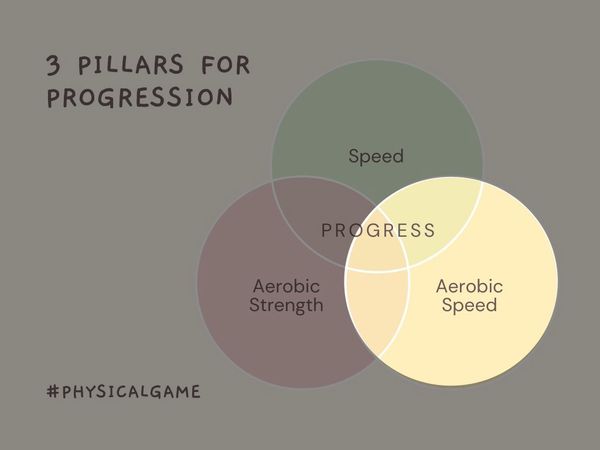This pillar is super simple. Imagine how fast you could go at your top end speed if you could already go at a relatively fast pace at your aerobic level: this is totally trainable and achievable if and only if you can nurture your ego enough to develop your aerobic system, simply by learning to train long and steady, often ignoring the urge to train fast. There are many ways by which you can do this.
Maximum Aerobic Function (MAF)
Use a measured distance or a running track to do repeated tests at your AT1 or aerobic threshold speed. A classic example would be a simple 5km time trial every month.
Checkpoints
These are ideal for long runs. Use a lower intensity set point again - let’s say 65% of your max h/rate. Start adding checkpoints into your longer runs; say every 3kms, through which you keep the same heart rate every distance interval but slowly try to develop speed at a very aerobic level. Doing this creates amazing confidence, especially when you start seeing gradual increases in efficiency, form and speed.
Measure Watts @ Aerobic Threshold
We are great at measuring FTP on the bike but not so great at measuring AT1 power (in watts). Again, this is highly trainable. The faster you can ride at AT1 wattage, the more capacity you can create for your engine.
This incorporation once again comes down to a strength component. In my own experience, for example, all of my 10km run PBs and 40km TT bike PBs happened when my AT1 was at its peak and the same has been true of almost everyone I have coached.
Develop Your Swim Based Aerobic Speed
Throw your 50s and 100s onto the back burner for a bit and focus on longer reps, working your aerobic speed. 400, 600 & 800m repeats focusing on rhythm, function and relaxing (yes, relaxing!) are ideal.
Water speed is a measure of your ability to relax, as tension in the water equates to a slow-moving dead weight. Let the water support you. Learn to swim sustainably before you go anywhere near 50m and 100m repeats.

Show Up, Don’t Blow Up
Why should we train aerobic speed across the board? I will give you one word to chew on: sustainability. This word is a moving target. As you develop aerobically, the level of sustainability of your higher training paces develops too – the two are positively correlated.
Lactate Tolerance
For argument’s sake, if two of us are running at 4min/km and my lactate is 2mmol/L and yours is 4mmol/L, who do you think will be able to run sustainably faster at their top end speed?
I have quite literally seen people starting a 5km MAF at 25mins and reducing it to 18mins, simply by increasing their lactate tolerance. Now the impact of this, even over only 5km, is clear.
Misinterpretation
People misinterpret what they see at the pointy end of sport. I know from coaching professionals that their speed was a product of their engine not of one-off sessions.
People would comment on what they were seeing, which was a fast athlete. They would read about their speed sessions, yet, what they misinterpreted was the fact that each athlete had developed amazing aerobic power. They just saw speed, but that speed was simply a component of aerobic power. What is speed if it is not a result of aerobic power?
Aerobic power
I have observed some athletes getting down towards 3min kms when running, at relatively aerobic heart rates. I have witnessed athletes first-hand running 4min kms in their recovery segments between speed reps. How did they do this? Through aerobic power! This concept applies to all of us from beginner to world champion. Aerobic power is the ultimate measure of your current ability to perform sustainably.
Fallback
One of the most important aspects of physical training that I never see much written or spoken about is fallback. Fallback pace for me as a coach is the pace you automatically fall back to when you are not feeling good.
Now this again is simple. If you are aerobically well conditioned and have good aerobic speed, then when things are less than great, you can reasonably expect to fall back to your aerobic functionality while you wait for things to improve provided you can stay positive mentally.
So, if your aerobic speed is good and you can hold, for example, 5min/km at fallback pace, that’s great.
However, conversely, what if your fallback is choppy and lies between 5:45 and 6:20? It does not take a great deal of thought to observe the ramifications of poor aerobic functionality, focus and speed.
You Lead They Bleed
In time, if you make these pillars your focus and pay attention to them, they will pay you back in results. People will wonder what has happened to you: how you got so fast, and what you are doing! It really is a simple case of input/output, and it is the old physical law of what you sow, you reap.
